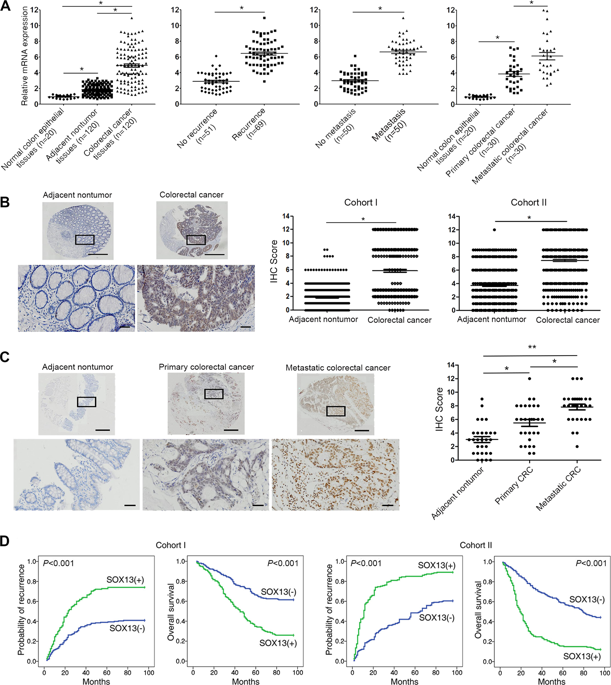Oncogene ( IF 8 ) Pub Date : 2020-02-28 , DOI: 10.1038/s41388-020-1233-4 Feng Du 1, 2, 3 , Xiaowei Li 4 , Weibo Feng 2 , Chenyang Qiao 2 , Jie Chen 2 , Mingzuo Jiang 2 , Zhaoyan Qiu 5 , Meirui Qian 2 , Dean Tian 1, 6 , Yongzhan Nie 2 , Daiming Fan 2 , Kaichun Wu 2 , Limin Xia 1, 2, 6

|
Metastasis is a major cause of high recurrence and poor survival of patients with colorectal cancer (CRC), although the mechanisms associated with this process remain poorly understood. In this study, we report a novel mechanism by which SOX13 promotes CRC metastasis by transactivating SNAI2 and c-MET. SOX13 overexpression was significantly correlated with more aggressive clinicopathological features of CRC and indicated poor prognosis in two independent cohorts of CRC patients (cohort I, n = 363; cohort II, n = 390). Overexpression of SOX13-promoted CRC migration, invasion, and metastasis, whereas SOX13 downregulation caused the opposite effects. Further mechanistic investigation identified SNAI2 and MET as important target genes of SOX13 using serial deletion and site-directed mutagenesis luciferase reporter and chromatin immunoprecipitation (ChIP) assays, as well as functional complementation analyses. In addition, SOX13 was shown to be a direct target of HGF/STAT3 signaling, and the c-MET inhibitor crizotinib blocked the HGF/STAT3/SOX13/c-MET axis, significantly inhibiting SOX13-mediated CRC migration, invasion and metastasis. Moreover, in clinical CRC tissues, SOX13 expression was positively correlated with the expression of SNAI2, c-MET, and HGF. CRC patients with positive coexpression of SOX13/SNAI2, SOX13/c-MET, or HGF/SOX13 exhibited a worse prognosis. In summary, SOX13 is a promising prognostic biomarker in patients with CRC, and blocking the HGF/STAT3/SOX13/c-MET axis with crizotinib could be a new therapeutic strategy to prevent SOX13-mediated CRC metastasis.
中文翻译:

SOX13 通过反式激活 SNAI2 和 c-MET 促进结直肠癌转移
转移是结直肠癌 (CRC) 患者高复发率和低生存率的主要原因,尽管与此过程相关的机制仍然知之甚少。在这项研究中,我们报告了一种新机制,通过该机制,SOX13 通过反式激活SNAI2和c-MET促进 CRC 转移。SOX13 过表达与 CRC 更具侵袭性的临床病理学特征显着相关,并且在两个独立的 CRC 患者队列(队列 I,n = 363;队列 II,n = 390)中表明预后不良。SOX13 的过表达促进了 CRC 的迁移、侵袭和转移,而 SOX13 的下调导致了相反的效果。进一步的机制研究确定了 SNAI2和遇见作为 SOX13 的重要靶基因,使用连续缺失和定点诱变荧光素酶报告基因和染色质免疫沉淀 (ChIP) 测定,以及功能互补分析。此外,SOX13 被证明是 HGF/STAT3 信号传导的直接靶标,c-MET 抑制剂克唑替尼阻断 HGF/STAT3/SOX13/c-MET 轴,显着抑制 SOX13 介导的 CRC 迁移、侵袭和转移。此外,在临床 CRC 组织中,SOX13 的表达与 SNAI2、c-MET 和 HGF 的表达呈正相关。SOX13/SNAI2、SOX13/c-MET 或 HGF/SOX13 共表达阳性的 CRC 患者预后较差。总之,SOX13 是一种有前途的 CRC 患者预后生物标志物,


























 京公网安备 11010802027423号
京公网安备 11010802027423号